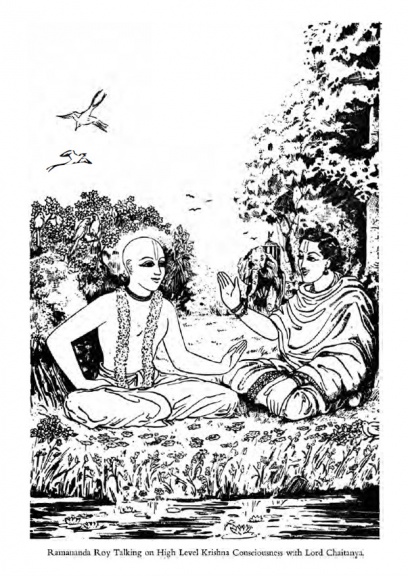TLC 27 (1968)
CHAPTER TWENTY-SEVEN

Lord Chaitanya and Ramananda Roy

The author of Chaitanya Charitamrita has described Lord Chaitanya Mahaprabhu as the ocean of transcendental knowledge, and Sri Ramananda Roy as the cloud which is produced from the ocean. Ramananda Roy was a greatly advanced scholar in devotional service, and by the grace of Lord Chaitanya he gathered all such transcendental conclusions, just as the cloud achieves its existence from the water of the ocean. As the cloud appears from the ocean and redistributes water all over the world, and then again goes back to the ocean, so by the grace of Lord Chaitanya Ramananda Roy achieved his higher knowledge in devotional service, and thus he again went to Lord Chaitanya at Puri after retirement from service.
When Lord Chaitanya was visiting the southern part of India, He first of all visited the great temple Bisakhapattan, the temple known as Jiayar Nrishingha Kshetra. It is situated at a place known as Singachalam, five miles from the railway station Bisakhapattan. The temple is situated on the top of a hill, and there are many temples in that quarter, but Jiayar Nrishingha Kshetra temple is the biggest of them all. The temple is full of beautiful sculpture, still wonderful for many students; and, on account of its popularity, it is a very rich temple. There is an inscription in the temple which states that the king of Vijynagar formerly decorated this temple with gold, and smeared the body of the deity with gold. For facilitating attendance at the temple there are free apartments for the visitors. The temple is managed by priests who belong to the sect of Ramanujacharya.
When Lord Chaitanya visited this temple He praised the deity, and He quoted a verse from Srimad Bhagwatam: "Although Lord Nrishingha is very servere to the demons and the non-devotees, He is very kind to His submissive devotees like Prahlad." Lord Nrishingha appeared as an incarnation of Krishna when Prahlad, a boy devotee of the Lord, was too much harassed by his father, Hiranya Kasipu. As the lion is very ferocious to other animals, but is very kind and submissive to his cubs, so Lord Nrishingha, although He appeared ferocious to Hiranya Kasipu, was very kind to Prahlad, His devotee.
After visiting the temple of Jiayar Nrishingha, the Lord proceeded farther south into India, and ultimately He reached the bank of the Gudabudee. On the bank of the Gudabudee the Lord remembered the Yamuna of Vrindaban, and the nice trees on the bank were considered by Him the forest of Vrindaban; so He was in ecstasy there. After taking His bath on the bank of the Gudabudee, the Lord was sitting a little off from the bank and was chanting Hare Krishna, Hare Krishna, Krishna Krishna, Hare Hare/Hare Rama, Hare Rama, Rama Rama, Hare Hare. Sitting in that way, the Lord saw that the governor of the province, Sri Ramananda Roy, had reached the bank of the river accompanied by his associates, many Brahmins, and a band party. The Lord had asked about Ramananda Roy, the governor of this province, from Sarbabhouma Bhattacharya, and the Lord was requested by Sarbabhouma Bhattacharya to see the great devotee Ramananda Roy at Kabur.
The Lord could understand that this man approaching was Ramananda Roy, and He wanted to see him immediately. But, because He was in the renounced order of life, He restrained Himself from seeing a person of political affairs. But Ramananda Roy, as a great devotee, was attracted by the Features of Lord Chaitanya as a Sannyasi, and he himself came to see Him. Ramananda Roy, on reaching Chaitanya, prostrated himself to offer Him obeisances and respect. Lord Chaitanya received him by vibrating Hare Krishna, Hare Krishna, Krishna Krishna, Hare Hare/Hare Rama, Hare Rama, Rama Rama, Hare Hare. When Ramananda Roy presented his credentials, Lord Chaitanya embraced him, and both of them became overwhelmed with ecstasy. The Brahmins who accompanied Ramananda Roy were surprised that these two persons were overwhelmed with transcendental ecstasy simply by embracing. The Brahmins were all stalwarts of the rituals, and they could not understand the meaning of these devotional symptoms. They were rather surprised to see that a great Sannyasi could touch a Sudra, and they were also surprised that Ramananda Roy, who was a great governor, and practically king of that province, was crying simply by touching a Sannyasi. While the Brahmins were considering this, Lord Chaitanya understood the unfavorable situation, and He pacified Himself.
After this, Lord Chaitanya and Ramananda Roy both sat down together, and Lord Chaitanya informed him that, "Sarbabhouma Bhattacharya has spoken very highly of you, so I have come to see you."
Ramananda Roy replied, "Sarbabhouma Bhattacharya considers myself as one of his devotees, and therefore he very kindly recommended You to see me." Ramananda Roy very much appreciated the Lord's behavior for His touching a man of wealth. A king or governor or any politician is always absorbed in thoughts of political affairs and pounds-shilling-pence; therefore, such persons are avoided by a Sannyasi. But Lord Chaitanya knew Ramananda Roy to be a great devotee, and so He did not hesitate to touch and embrace him. Ramananda Roy was surprised by the behavior of Lord Chaitanya, and he cited a nice verse from Srimad Bhagwatam, in which it is stated that, "The great personalities and sages appear in the houses of worldly men just to show them mercy."
Lord Chaitanya's special treatment of Ramananda Roy indicated that, although Ramananda Roy was born of a family who were not Brahmins, still he was far, far advanced in spiritual knowledge and activity. Therefore he was more respectable than a Brahmin who happens to born in a Brahmin family. Although Sri Ramananda, out of his meek and gentle behavior, accepted himself as born of a lower Sudra family, still Lord Chaitanya considered him to be situated in the highest transcendental stage of great devotion. The devotees never advertize themselves as being great, but the Lord is very anxious to advertize the glory of the devotee. Ramananda Roy and Lord Chaitanya, just acquainted for the first time that morning at the bank of the Gudabudee, separated, and there was an engagement made that Ramananda Roy would come in the evening to see the Lord.
In the evening, when the Lord was seated after taking His bath, Ramananda Roy came to see Him with a servant. He offered his respects and sat down before the Lord. Before Ramananda Roy could ask the Lord anything about advancement of spiritual knowledge, the Lord Himself inquired, "Please quote some verses from Scripture about the ultimate goal of life for the human being."
Sri Ramananda Roy at once replied to the Lord that, "A person who is sincere in his occupational duty will gradually develop the sense of God consciousness." In this connection he quoted a verse from the Vishnu Purana, in which it is stated that the Supreme Lord is worshipped by following the principles of one's occupational duty, and there is no other alternative for satisfying the Supreme Lord from the formalities of performing one's occupational duties. The purport is that human life is meant for understanding one's relationship with the Supreme Lord and acting in that way. Any human being can dovetail himself with the service of the Lord by discharging his prescribed duties or occupational performances.
For this purpose, human society may be divided into four classes: namely, the intelligent class, or the Brahmins, the administrative class, or the Kshatriyas, the merchantile, or productive class, called Vaishyas, and the laborer class or the helping class, the Sudras. For each division of human society there are prescribed rules and regulations and occupational functions. The prescribed duties of the four classes or four divisions of human society are very nicely described in the Bhagavad Gita, Eighteenth Chapter, 42-44 verses. An organized, civilized society of humanity should follow such prescribed rules and regulations for particular divisions. At the same time, for spiritual advancement, they must follow the four stages of Ashrama: namely, the student life, which is called Brahmachary life; then householder's life, then retired life, and then renounced life.
Ramananda Roy stated that persons who are strictly following the rules and regulations of these eight divisions of human society are the best, and they are actually satisfying the Supreme Lord. One who does not follow the principles of the social division and the rules of spiritual advancement is certainly spoiling his human form of life and gliding down towards hell. One can peacefully execute the goal of his human life simply by following the rules and regulations which apply to himself. The character of a particular person becomes developed by following the principles of regulation according to his birth and association and education. The divisions of society are so designed that many persons of different characteristics can be regulated under them, for the peaceful administration of social life and spiritual advancement. The social divisions of human society may be divided as follows: 1. One who has taken as the aim of his life to understand the Supreme Lord, the Personality of Godhead, and for which aim he has devoted himself to the learning of the Vedas and similar literatures, is called a Brahmin. 2. A person who has taken to the occupation of showing his force and of administering the government is called a Kshatriya. 3. One who is engaged in agriculture and herding cows and trade and business is called a Vaishya. 4. Persons who have no special knowledge but are satisfied by serving the three other higher social divisions are called Sudras. If one faithfully discharges his prescribed duties, it is surely an advancement toward perfection. Therefore, regulated life is the source of perfection for everyone. This regulated life, when culminating in devotional service to the Lord, attains its perfection. Otherwise it is a useless waste of time.
Therefore, Lord Chaitanya, after hearing from Ramananda Roy about the proper execution of regulated life, said that this is external. Indirectly, He asked Ramananda to state something which is better than this external exhibition of life. Formal execution of this ritualistic life or religious life is not very congenial unless it attains the perfection of devotional service. Actually Lord Vishnu is not satisfied simply by the ritualistic performance of Vedic instructions, but He is actually pleased when one attains the stage of devotional service.
The verse cited by Ramananda Roy in reply to Lord Chaitanya means that, by the divisional ritualistic performances, one can rise up to the point of devotional service. In the Bhagavad Gita we find that Lord Sri Krishna, Who appeared Himself for the deliverance of all classes of people, has mentioned that the human being can attain the highest perfectional stage of life by worshipping the Supreme Lord, from Whom everything has emanated, by dint of his occupational duties. It is stated in the Bhagavad Gita: "A person duly engaged in his occupational duties attains the highest perfection." This perfectional process is followed by great devotees like Bodhyana, Tanaka, Dramida, Guhadeva, Kapardi, Bharuchi—all these great personalities have followed this particular path of perfection of the human life. The Vedic injunctions also aim at this point of life. Ramananda Roy wanted to present this fact before the Lord. But, apparently, simply discharging the ritualistic duties is not perfection. Therefore Lord Chaitanya said that it is external. Lord Chaitanya's purport was that a man having a material conception of life, even if he follows the ritualistic regulations, cannot attain the highest perfection.